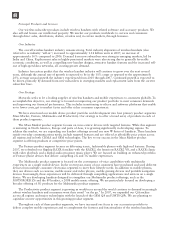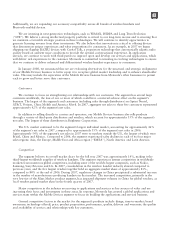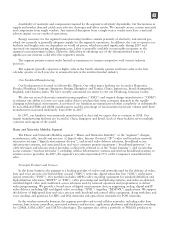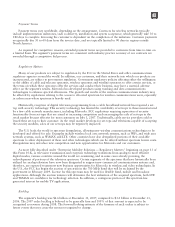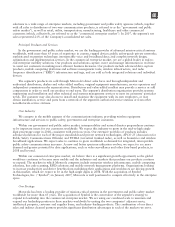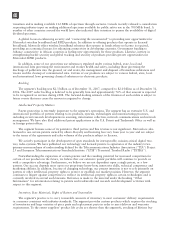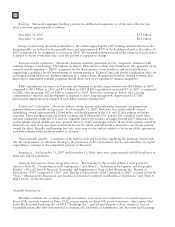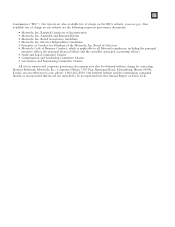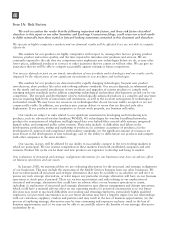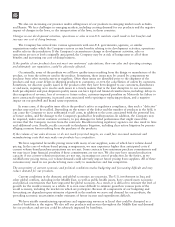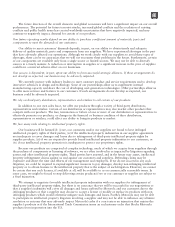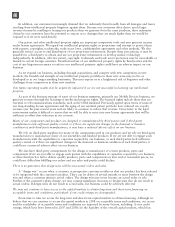Motorola 2007 Annual Report Download - page 20
Download and view the complete annual report
Please find page 20 of the 2007 Motorola annual report below. You can navigate through the pages in the report by either clicking on the pages listed below, or by using the keyword search tool below to find specific information within the annual report.
In the government and public safety market, our objective is to maintain our leading position as the market
and technology evolves. Key strategies include: (i) continuing investment in our analog radio portfolio while
leading the ongoing migration to digital products, (ii) leveraging our wireless broadband portfolio to drive growth
and enter new markets, (iii) managing the anticipated public/private convergence planned for potential 700MHz
public safety systems in the U.S., and (iv) continuing to lead the market for APCO 25 and TETRA standards-based
voice and data networking systems around the world.
In the commercial enterprise market, our strategy is to deliver products and solutions that are designed to
increase cost effectiveness, enhance efficiency and promote faster execution of critical business processes. Key
strategies include offering a comprehensive portfolio of products and services to help businesses: (i) streamline their
supply chains, (ii) improve customer service in the field, (iii) increase data collection accuracy, and (iv) enhance
worker productivity.
Customers
Our products and services are sold worldwide to a diverse set of customers, including government and public
safety agencies (police, fire, and emergency management services) and militaries, as well as retail, utility,
transportation and logistics, manufacturing, wholesale and distribution, healthcare and other commercial
customers. Our sales model emphasizes both direct sales by our in-house sales force and indirect sales through our
channel of value-added resellers and distributors. We believe this dual sales approach allows us to meet customer
needs effectively, build strong, lasting relationships and broaden our penetration across various markets. Our
channel sales force allows us to increase revenues by extending the reach of our products and solutions to meet
demand in market segments where our direct sales force does not sell. Resellers and distributors each have their
own sales organizations which complement and extend our sales organization. With deep expertise about specific
customers’ operations, resellers can be very effective in promoting sales of Motorola products. We believe this
tiered distribution approach will allow us to achieve our goal of maintaining gross margin over time, as we drive
greater scale from shipping more efficiently through better management of our supply chain.
The largest of the segment’s customers are the U.S. Government, Scansource, IBM, Ingram Micro and
Wal-Mart. In 2007, aggregate net sales to these five customers represented approximately 19% of the segment’s net
sales. The loss of any of the segment’s largest customers may have a material adverse effect on the segment’s
business. Further, because some of these contracts are long-term, the loss of a major customer could impact
revenue and earnings over several quarters. Net sales to customers in North America represented 62% of the
segment’s net sales in 2007.
A majority of our sales were made directly through our in-house sales force. However, as noted above, a
significant portion of our sales are made through resellers and distributors. Our largest resellers and distributors
are Scansource, IBM and Ingram Micro, which primarily sell to the commercial enterprise market.
Competition
The businesses in which we operate are highly competitive. Continued evolution in the industry, as well as
technological migration, is opening up the market to increased competition. Other key competitive factors include:
technology offered; price; payment terms; availability of vendor financing; product and system performance;
product features, quality, delivery, availability and warranty; the quality and availability of service; company
image; relationship with key customers; and time-to-market. We believe we are uniquely positioned in the industry
due to our strong customer relationships, our technological leadership and capabilities, and our range of offerings.
The segment experiences widespread competition in the government and public safety market from a growing
number of new and existing competitors. In this market, the segment provides communications and information
systems compliant with both existing industry digital standards, APCO 25 and TETRA. Major competitors
include: M/A-Com, EADS Telecommunications, Kenwood, EF Johnson, Cisco and large system integrators.
Competitors in this segment may also serve as a subcontractor to a large system integrator and are selected
based on a number of competitive factors and customer requirements. The segment is managing the impact of
system integrators seeking to move further into the public safety area, specifically in the federal government
market. Several other competitive factors may have an impact on the business, including: the consolidation among
telecommunications equipment providers; evolving developments in the 700 MHz band, and increasing
encroachment by broadband and IP solution providers. As demand for fully-integrated voice, data and broadband
systems continues, the segment may face additional competition from public telecommunications carriers.
12


